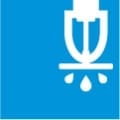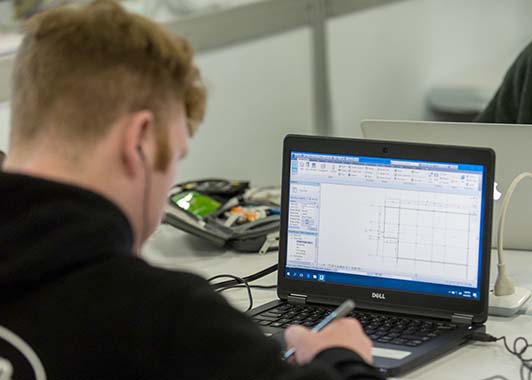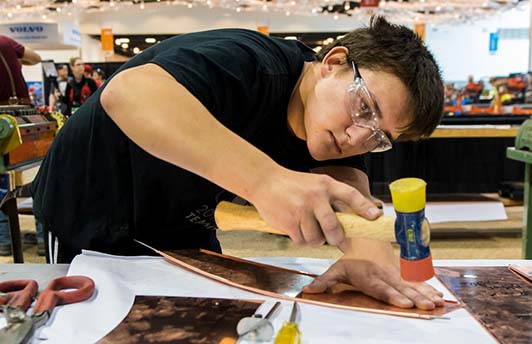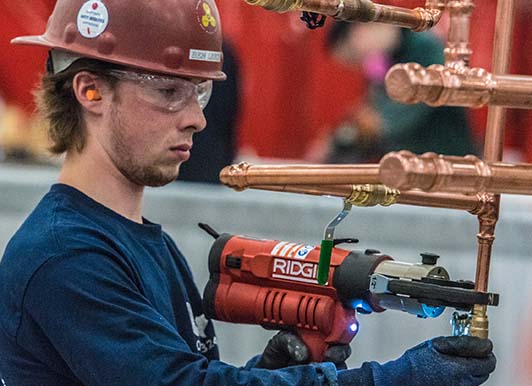Sprinkler Fitter
What is sprinkler fitting?
Sprinkler System Installers fabricate, install, test, maintain and repair water, foam, carbon dioxide and dry chemical sprinkler systems in buildings for fire protection purposes.
To install wet and dry pipe sprinkler systems, carbon dioxide, chemical and foam extinguishing systems, stand pipe and hose systems and fire pump systems, installers:
- Support the safe execution of work
- Read and interpret drawings, specifications and fire codes to determine layout requirements
- Install clamps, brackets and hangers to support piping system and sprinkler and fire protection equipment, using hand and power tools
- Select, measure, cut, ream and thread pipe, install sprinkler heads and mount prepared pipe in supports
- join and connect pipes and piping sections to related piping systems, tanks, mains, pumps, compressors and control equipment using various pipe joining methods,
- Connect piping system to water mains, supply tanks, pumps, compressors and control equipment
- Installs valves, alarms and associated equipment
- Test system for leaks using air or liquid pressure equipment
- inspect, maintain and repair piping, fixtures and controls including hydrant, pump and sprinkler head connections,
- Service and repair sprinkler system
- Read and interpret work specifications and fire codes
- May prepare cost estimates for clients.
HOW TO JOIN THE FIELD
Completion of secondary school is usually required.
Completion of a four- to five-year apprenticeship program
or
A combination of over five years of work experience in the trade and some high school, college or industry courses in steamfitting, pipefitting or sprinkler system installation is usually required to be eligible for trade certification.
Sprinkler system installer trade certification is compulsory in Nova Scotia, New Brunswick, Quebec and Manitoba and available, but voluntary, in all other provinces and the territories.
Sprinkler system installer (no construction) trade certification is compulsory in Quebec.
Red Seal endorsement is also available to qualified steamfitters-pipefitters and sprinkler system installers upon successful completion of the interprovincial Red Seal examination.
Apprenticeship training programs for steamfitters, pipefitters and sprinkler system installers vary across Canada. For sprinkler system installers they generally involve four 12-month periods, including at least 6,600 hours of on-the-job training, three seven-week blocks of technical training and a final certificate exam.
INDIGENOUS AND REMOTE CONSIDERATIONS
Indigenous and remote communities may not have many people who work in this trade, so there likely wouldn’t be too much choice in jobs in this field. In small, fly-in communities, there may be only one or two companies to work for while staying in their home community. This may mean someone pursuing this trade will be looking at relocation or travelling to nearby communities.
With math literacy in the north being lower than in other places, northern and remote students may need extra support in order to pass tests and get their red seal.
DISABILITY CONSIDERATIONS
With this job being heavy manual labour, it may not be possible for someone with a severe physical disability. Accommodations may be necessary for someone with a learning disability. The confinement of the working conditions may worsen anxiety disorders. A person suffering from anxiety may need accommodations to make this career possible.
Find the right career path for you with our interactive map!
Trouvez le cheminement de carrière qui vous convient grâce à notre carte interactive!
Sample Job Titles
- Fire protection mechanic
- Fire sprinkler fitter
- Sprinkler system fitter
Companies and Sectors
- Mechanical Construction firms
- Plumbing contractors
- Heating and Air Conditioning companies
- Building developers
- Sprinkler system contractors; and
- Self-employed

Sprinkler Fitter and the Skills for Success Program
The key Skills for Success for this career path are:
- Reading
- Numeracy
- Collaboration




